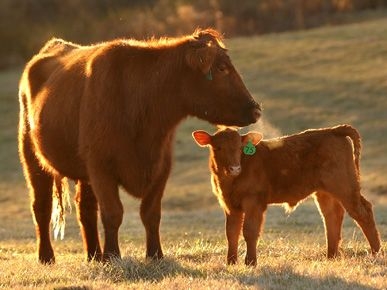UC helps cattle ranchers estimate costs and returns of beef production
The cattle industry in California has undergone dramatic changes over the last few decades. International competition and opportunities, new regulatory requirements, fluctuating feed costs, changing consumer demand, economies of scale and competing land uses all affect the bottomline in cattle ranching. Ranchers have experienced increasing production costs while revenue has not kept pace with costs.
To help ranchers make business decisions, new cost studies for beef cattle production have been released by UC ANR Agricultural Issues Center and UC Cooperative Extension.
Sample costs and returns for beef cattle production in the northern Sacramento Valley are presented in these studies. The studies are titled “Sample Costs for Beef Cattle, Cow–Calf Production,” “Sample Costs for Beef Cattle, Yearling/Stocker Production” and “Sample Costs for Beef Cattle, Finished on Grass.”
"These studies are useful to new and experienced ranchers, lenders and other agribusiness companies, as well as government officials, researcher and students who want to know basics of ranch practices and the costs and returns that can be expected for a well-managed operation,” said Daniel Sumner, director of the UC Agricultural Issues Center. “The studies show ranges of net returns under alternative price scenarios to help indicate sensitivity of returns to cattle market conditions."
The analyses are based on a hypothetical well-managed ranching operation using practices common to the northern Sacramento Valley. The three studies are based on a herd of 300 cows and bred heifers, 60 yearling heifers and 15 bulls. An 11 percent cull rate is applied to the herd. An 89 percent calf crop with three percent mortality before weaning is assumed.
All rangeland and pasture is rented per animal unit month. Ranging analysis tables show net revenue over a range of prices. The costs, materials and operations shown in this study will not apply to all ranches. Ranchers, UC Cooperative Extension farm advisors, and other agricultural associates provided input and reviewed the methods and findings of the study.
Free copies of these studies and other sample cost of production studies for additional commodities are also available. To download the cost studies, visit the UC Davis Department of Agricultural and Resource Economics website at https://coststudies.ucdavis.edu.
The cost studies program is funded by the UC Agricultural Issues Center and UC Cooperative Extension, both of which are part of the UC Division of Agriculture and Natural Resources, and the UC Davis Department of Agricultural and Resource Economics.
For more information or an explanation of the calculations used in the studies, contact Donald Stewart at the Agricultural Issues Center at (530) 752-4651 or destewart@ucdavis.edu; Larry Forero, UC Cooperative Extension farm advisor for Shasta and Trinity counties, at lcforero@ucanr.edu, or Jeff Stackhouse, UC Cooperative Extension farm advisor for Humboldt and Del Norte counties, at jwstackhouse@ucanr.edu.
NOTE: Corrections were made on July 19, 2017, to “2017 Beef Cattle Yearling/Stocker Production in the Sacramento Valley” and “2017 Beef Cattle Finished on Grass in the Sacramento Valley” to show interest calculated for 6 months as stated in the narratives of both studies, instead of 12 months.

